Stick Stone
Stone Adhesive: Strong Glue to Stick Stone
When you’re looking to stick stone, Adiseal is a great adhesive to glue stone. Adiseal stone adhesive will bond stone to many different materials including wood, metal, concrete, plastic, tile, polystyrene, masonry, glass & many other items.
Adiseal adhesive for stone and rocks outperforms other adhesives when it comes to gluing stones. It is suitable at bonding many different types of stone including marble, granite, travertine, Indian stone, sandstone, limestone, rocks, stone veneer, stone cladding, natural stone & slate just to name a few. It is suitable for both interior and exterior stone adhesive bonding applications.
- Why Adiseal is great adhesive for stone
- How to stick stone with a stone glue
- How to bond wood to stone
- Glue for stone
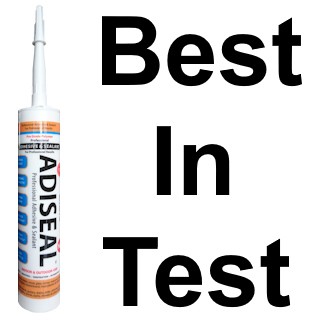
Why Adiseal is great adhesive for stone
There are many reasons why Adiseal adhesive & sealant is a great adhesive for stone.
- Adiseal is the record breaking strongest adhesive & sealant. It has proved it’s the best product in an independent adhesive strength test by Ultimate Handyman.
- Adiseal stays permanently flexible so it will absorb any vibration and allow any items to expand and contract without the construction adhesive becoming weak. This makes the adhesive highly durable.
- Adiseal is a waterproof sealant and waterproof adhesive so it is also suitable for use outside as well as inside. It also seals underwater & glues underwater.
- Priming the material should not be required as long as the surface is clean of any dust, grease, paint or any other dirt.
- It does not stain or bleed into stone or masonry.
- Adiseal has very high gap fill properties.
- It has high initial grab meaning temporary supports may not be required while the adhesive cures. Adiseal Hi-Grab has even higher grab than the standard product, see below for details.
- When bonding with Adiseal, some natural stone which are porous does not require sealing prior to applying the adhesive.
- Suitable as an indoor and outdoor adhesive sealant making it also a great exterior grab adhesive.
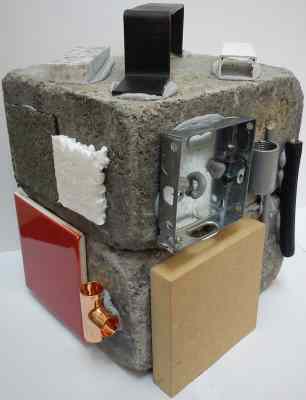
On our concrete demonstration block above, we have stuck many different items using Adiseal adhesive sealant. We have also bonded marble to concrete, with Adiseal adhesive sealant being used as a stone glue.
Independent strongest adhesive test results
In the independent adhesive strength test by Ultimate Handyman, Adiseal was over 3 times stronger than the nearest competitor. The test on Adiseal was forced to be stopped as the screws holding the test rig down started to rip out.
Best adhesive test results table
| Product | Max pressure when adhesive bond broke (psi) |
| Adiseal | 3123 + psi |
| SupaBond | 1115 psi |
| Tec 7 | 1016 psi |
| HB42 | 942 psi |
| Loctite PL Premium | 873 psi |
| Gorilla Grab Adhesive | 862 psi |
| Bond It PU18 | 582 psi |
| Bond It Save Nails | 411 psi |
“That is actually unbelievable!”
Ultimate Handyman
Testimonials
Testimonials & some comments on the: Grab adhesive tests 2017, video on YouTube
- That Adiseal is phenomenal!
- That Adiseal is some stuff though, definitely need to get some of that bought!
- I instantly went looking for Adiseal!
- Need to get my hands on some of that to try out.
- Looks like a cracking product.
- Having used the two most expensive brands on numerous occasions, I’ll be trying out the others, especially the Adiseal.
- Adiseal certainly surprised me in this test!
- Fantastic tests. It’s unbelievable that Adiseal test with the hardwood.
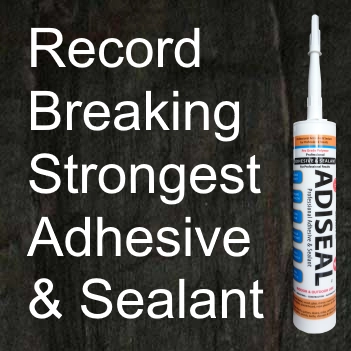
Adiseal Adhesive & Sealant vs Adiseal Hi-Grab
Adiseal adhesive sealant has high initial grab but for even more grab use the Adiseal Hi-Grab adhesive. The final bond strength of both construction adhesives is similar.
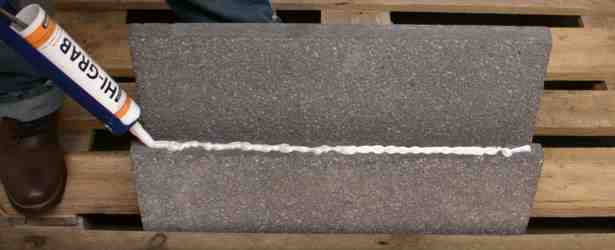
Adiseal Hi-Grab is great for holding heavy items on vertical surfaces, preventing sliding before the adhesive sets and possibly avoiding temporary supports. It also has higher gap-filling capabilities compared to the standard Adiseal adhesive sealant, but it requires more force to push items close together due to its thicker consistency. To narrow the gap between items, the standard Adiseal adhesive sealant is recommended to provide a better and closer bond. Use a high-quality caulking gun for precise dispensing of Adiseal Hi-Grab.
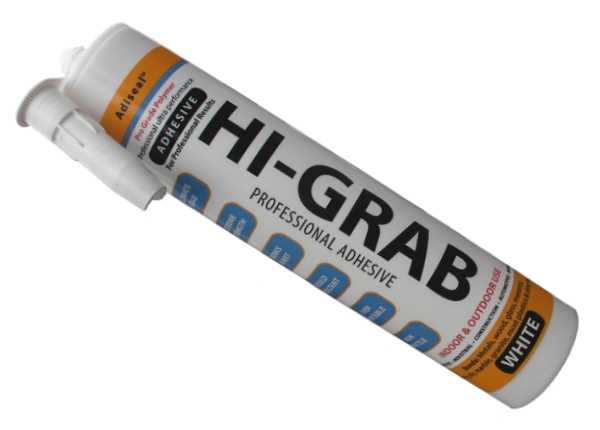
Problems with using glue on stone
Glues are suitable for lightweight bonding on smooth surfaces, but insufficient for heavy-duty stone bonding applications. For robust bonding, a construction adhesive like Adiseal is recommended due to higher gap fill, initial grip, bond strength, and flexibility. Some natural stone is porous which requires pre-sealing before using a liquid glue. This is not a problem for Adiseal adhesive for stone.
How to stick stone with a stone glue
How to glue stone
- Clean surface.
Making sure the materials are clean is vital to get a good quality bond. Brush of any dust thoroughly prior to applying the adhesive. We recommend using a fine brush like a painting brush to remove fine dust.
- Sealing stone?
A common problem when using other adhesives or glue for stone is they tend to bleed into the stone. As some natural stone is porous, it requires sealing first before applying any adhesive or stone glue. Instead of using these other adhesives or glue for stone, using Adiseal will avoid this problem.
- Apply stone glue or adhesive.
Apply the stone glue or adhesive to 1 surface and firmly push the items together. It is not necessary to cover the whole area with the adhesive as when the items are pushed together, the adhesive should naturally spread depending on how thick it was initially applied and the gap between the two items. Maximising the coverage will provide a stronger bond on stone.
- Hold stone in place.
Temporary supports may be required if the items starts to slide down. Adiseal can take 24 to 48 hours to fully dry. It has high initial grab but for even more instant grab use the Hi-Grab product.
- Remove excess.
Wipe away any excess stone adhesive or glue. Adiseal can be simply wiped away with a cloth. Use Adisolve to help remove and uncured Adiseal.
For safety reasons on extra heavy stone, brick, tile or other masonry items, mechanical fixings also need to be used in conjunction with Adiseal when used on to bond items to vertical & overhead applications.
Tip: To store Adiseal once opened, leave about 1cm worth of product out of the nozzle and store the tube upright in a cool dry place. Adiseal requires moisture for it to cure. The exposed part out of the nozzle will cure creating a cap. To re-use Adiseal, pull the cured part out or cut the nozzle until the uncured part is reached.
How to bond wood to stone
Adiseal effectively bonds wood to stone for strong, durable bonds for indoor and outdoor applications. To ensure optimal results, begin with clean surfaces, free from dust, grease, paint, or contaminants. Use a fine brush, like a painting brush, to remove fine dust from masonry and materials, enhancing the bonding process.
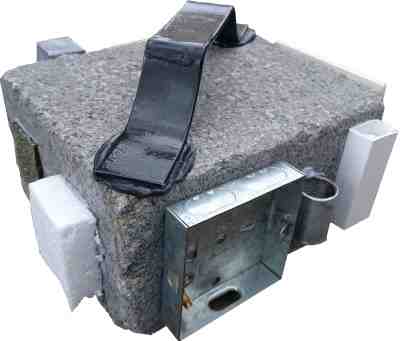
To bond effectively on concrete, start by brushing away dust with a paintbrush for a clean surface.
Once clean, apply adhesive to wood or stone and firmly press them together. In areas prone to water exposure, apply Adiseal in thin vertical strips to allow water to flow down instead of accumulating behind the bonded items, preventing potential expansion in cold temperatures.
Temporary supports may be needed if wood starts to slide, but they’re usually unnecessary. Wood absorbs moisture from the air and can expand, so using a flexible adhesive for wood-to-stone bonding is essential to accommodate this natural movement.
For safety reasons on extra heavy wood, mechanical fixings also need to be used in conjunction with Adiseal when used on to bond items to vertical & overhead applications.
How to glue metal to stone
To effectively bond metal to stone, ensure clean surfaces. Remove oil coatings from some metals with Adisolve. For a stronger bond, scuff the metal surface (not always necessary), then clean it thoroughly. Apply adhesive and press the metal onto the stone. Use Adiseal Hi-Grab adhesive or temporary supports if there’s a risk of sliding.
For safety reasons on extra heavy metal items, mechanical fixings also need to be used in conjunction with Adiseal when used on to bond items to vertical & overhead applications.
How to bond plastic to stone
Adiseal is suitable for bonding various plastics to stone. Before applying the adhesive, ensure the plastic is thoroughly cleaned to remove any dust, oil, grease, paint, or dirt. While not always necessary, lightly scratching the plastic’s surface can enhance the bond’s strength by increasing the surface area.
After both surfaces are clean, apply the adhesive and firmly press the item onto the stone.
Adiseal is also great when used to glue artificial grass to stone.
Please note Adiseal is not suitable at sticking polypropylene or polyethylene.
Glue for stone
You can use Adiglue to bond stone, although it’s less brittle than super glues, it lacks the flexibility and strength of Adiseal construction adhesive and construction sealant. For instance, in the example below, we used Adiglue to attach a metal handle to a concrete slab, which required sealing with Adiglue Activator to prevent absorption. In contrast, Adiseal construction adhesive and construction sealant can bond the same metal handle to concrete or stone without the need for sealing.

We have also stuck some bricks together and also brick to MDF with Adiglue to demonstrate what it is capable of. Sealing with Adiglue Activator was required first prior to applying the glue.
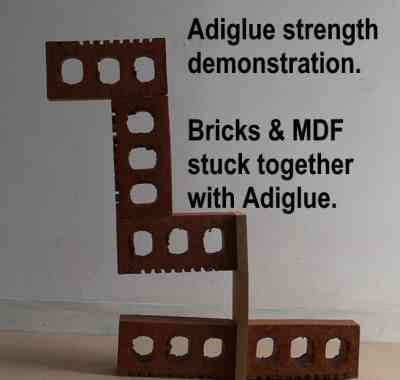
Glue for Marble
Adiseal adhesive sealant and Adiseal Hi-Grab are top choices for bonding marble. Clean both surfaces, and no need to seal the marble’s surface. After cleaning, apply the adhesive to one surface, press the marble onto the other, and for vertical or overhead applications, consider using mechanical fixings for safety. Adiglue can also be used but offers less strength and flexibility. If using Adiglue liquid glue, seal the porous marble first with Adiglue Activator. This step is unnecessary with Adiseal adhesive sealant or Adiseal Hi-Grab adhesive. Thorough cleaning with a fine brush is essential for a strong bond with any marble adhesive.
Adhesive for Granite
Adiseal adhesive sealant and Adiseal Hi-Grab are both great adhesive for bonding granite. Clean both surfaces, and no need to seal the granite. After cleaning, apply the adhesive to one surface and press the granite onto the other. For vertical or overhead applications, consider using mechanical fixings for safety.
While Adiglue can be used, it’s not as strong or flexible as Adiseal and Adiseal Hi-Grab. If using Adiglue, clean the granite, and use temporary supports as needed until the adhesive cures.
Adhesive for Slate
Adiseal and Adiseal Hi-Grab work well for slate applications. Clean both surfaces, and no need to seal the slate. After cleaning, apply adhesive to one surface, press the slate onto the other. For vertical or overhead applications, use mechanical fixings for added safety.
While Adiglue can be used, it’s not as strong or flexible as Adiseal and Adiseal Hi-Grab. If using Adiglue, clean the slate surfaces, and use temporary supports as needed until the adhesive cures.
Adhesive for Indian Stone
Adiseal adhesive and Adiseal Hi-Grab bond Indian stone effectively to various materials. Indian stone’s porosity requires compatible adhesives. Adiseal options prevent bleed-through and staining, ensuring a strong, waterproof, and flexible bond.
How to bond Indian Stone
Thoroughly clean surfaces for a strong bond by brushing away debris and dust with a fine brush. Apply the product to one surface, then press materials together. Temporary supports may be needed as curing can take about 48 hours.
Where to buy stone glue?
To buy stone glue or stone adhesive in the UK, contact us for your local stockist. For other countries, if there is no local distributor then you can buy from www.guglue.com
Frequently asked questions about sticking stone
Adiseal is the best adhesive to use on stone as it has proven to be the strongest adhesive by an independent adhesive strength test. Adiseal is flexible, waterproof, high gap fill, high grab, UV resistant and sticks almost any type of material to stone.
To remove adhesive from stone, use a sharp item like a knife or chisel. Usually chemical adhesive removers will not have any affect on stone adhesive.
As stone is a porous material, it will soak up any liquid glue or adhesive. With Adiseal this is not required as Adiseal will not soak into the stone. If the stone does require sealing for use with other adhesives, use the Adiglue Activator to seal it.
The best exterior stone adhesive is Adiseal. It is flexible, waterproof, high gap fill, high grab, UV resistant and can be painted over. It works in the dry, wet and even underwater. In an independent test, Adiseal has proven to be the strongest adhesive.
Stone glue is suitable for bonding a wide range of stone materials, including granite, marble, limestone, travertine, slate, and other natural or engineered stones.
Adiseal has been shown to be the strongest construction adhesive in an independent test. Adiseal will stick many different materials to stone of different types. It will provide an extra strong, flexible and waterproof bond that is very durable, weather resistant and has long longevity.
Adiseal is one of the strongest adhesives for stone, offering superior bonding strength, high gap fill properties, and flexibility, making it a reliable choice for various stone applications.
Adiseal construction adhesive creates a strong, flexible and waterproof bond on many different stone materials like marble and granite. With its formidable Adiseal Hi-Grab variant, it firmly secures stones without the need for temporary supports during the adhesive setting process. Moreover, Adiseal eliminates the necessity to seal stones beforehand as it does not bleed into or stain the stone surfaces. Adiseal has been shown to be the strongest construction adhesive in an independent adhesive strength test.
Adiseal has been shown to be the strongest adhesive in an independent adhesive strength test. It will provide a strong heavy-duty bond on stone and brick. It is also designed to stay flexible, waterproof and highly durable.
